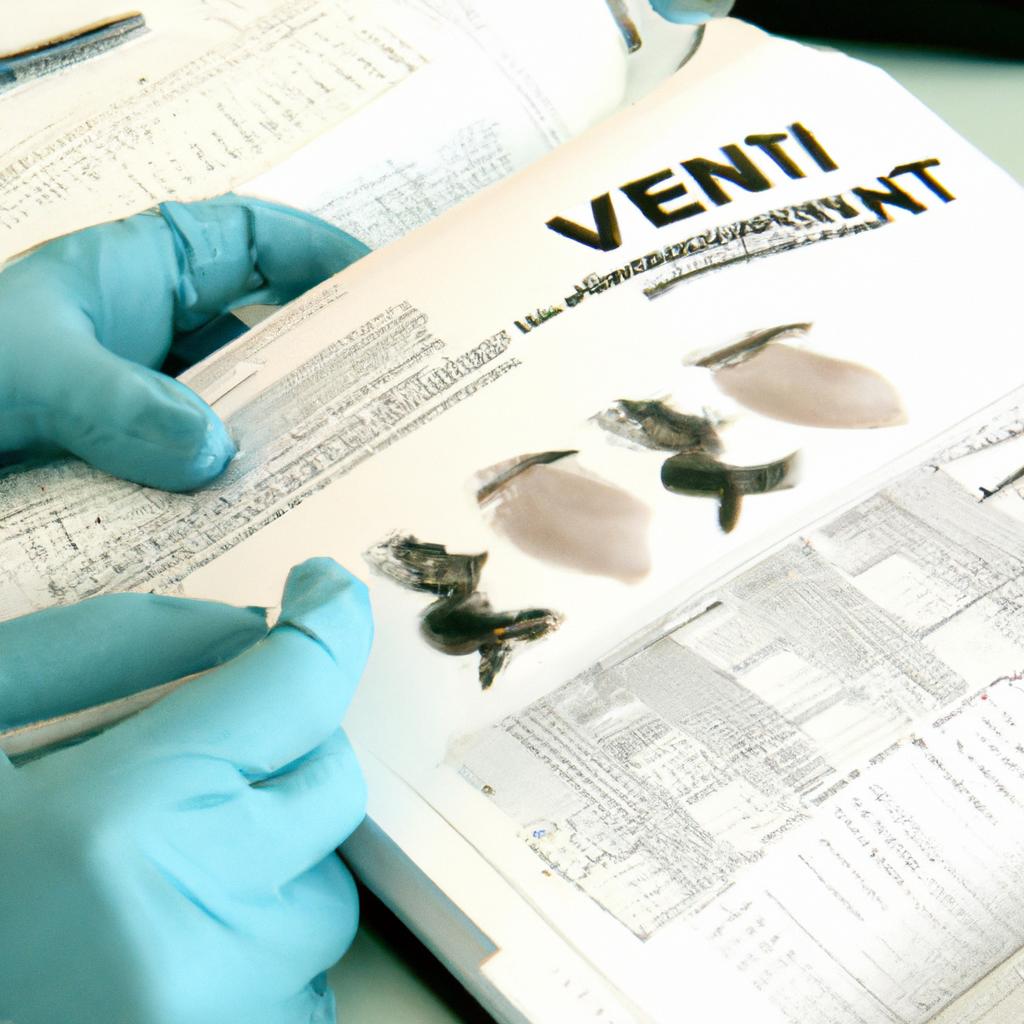Vaccination plays a crucial role in veterinary clinical pathology, as it aids in the prevention and control of infectious diseases among animals. Immunology insights provide valuable understanding of how vaccines stimulate immune responses and confer protection against pathogens. For instance, consider the case study of a dog presenting with symptoms indicative of canine distemper virus (CDV) infection. By examining the immunological mechanisms underlying vaccination, we can gain insight into the effectiveness of various vaccine strategies and their potential impact on disease outcomes.
In recent years, significant advances have been made in our understanding of the immune response to vaccination in veterinary medicine. Vaccines are designed to elicit an immune response that mimics natural infection without causing severe illness or harm to the host animal. This leads to the development of memory cells capable of recognizing specific antigens associated with pathogenic organisms. As a result, upon subsequent exposure to these pathogens, the vaccinated animal’s immune system can mount a rapid and robust defense, preventing or minimizing disease progression.
Understanding the immunological basis behind vaccination is essential for optimizing vaccine efficacy and improving overall animal health. Through this article, we aim to explore key immunology insights pertaining to vaccination in veterinary clinical pathology. By delving into topics such as antigen recognition, antibody production, cellular … cellular immune responses, and immune memory, we can better understand how vaccines work and the mechanisms by which they confer protection.
One important aspect of vaccination is antigen recognition. Vaccines contain specific antigens that are derived from the pathogens they aim to protect against. These antigens can be whole inactivated or attenuated microorganisms, purified proteins, or even genetic material encoding for these proteins. When a vaccine is administered, these antigens are presented to the immune system, specifically to specialized cells called antigen-presenting cells (APCs). APCs process and present the antigens to other immune cells, such as T cells and B cells.
Upon antigen presentation, B cells play a critical role in antibody production. B cells recognize the specific antigens through their surface receptors called B-cell receptors (BCRs). This recognition triggers a series of events that lead to B cell activation and differentiation into plasma cells. Plasma cells produce large quantities of antibodies that can bind to and neutralize the pathogen or its toxins. Antibodies can also facilitate other immune processes such as opsonization (marking pathogens for destruction) and complement activation.
In addition to antibody-mediated immunity, cellular immune responses are crucial for effective protection against certain pathogens. T cells, another type of lymphocyte, play a central role in cellular immunity. There are two main types of T cells involved in vaccination: helper T cells (CD4+) and cytotoxic T lymphocytes (CTLs) (CD8+). Helper T cells help coordinate and regulate the immune response by secreting cytokines that activate other immune cells. CTLs directly kill infected host cells carrying the pathogen or release cytokines that aid in clearing infections.
Furthermore, vaccination leads to the generation of immunological memory. Memory B cells and memory T cells are long-lived subsets of these respective cell types that remain in circulation after an initial infection or vaccination has been resolved. In subsequent encounters with the same pathogen, memory cells can quickly mount a more rapid and potent immune response. This immunological memory is the basis for long-term protection provided by vaccines.
Overall, understanding the immunology behind vaccination in veterinary clinical pathology helps us design and develop effective vaccines that provide robust and lasting immunity against infectious diseases in animals. By unraveling the intricate mechanisms of antigen recognition, antibody production, cellular immune responses, and immune memory, we can continue to advance veterinary medicine and ensure the health and well-being of our animal companions.
Importance of Vaccination in Veterinary Medicine
Importance of Vaccination in Veterinary Medicine
Vaccination plays a vital role in safeguarding the health and well-being of animals, providing protection against various infectious diseases. One such example is the case study of a canine parvovirus outbreak that occurred at a local animal shelter. Prior to implementing a vaccination program, multiple dogs were infected with this highly contagious virus, leading to severe illness and even death. However, after implementing routine vaccinations, the incidence of parvovirus drastically decreased, demonstrating the effectiveness and significance of vaccination in veterinary medicine.
To further emphasize the importance of vaccination, it is essential to consider several key points:
- Prevention: Vaccines serve as an effective preventive measure against numerous infectious diseases prevalent in animals. By stimulating an immune response specific to each pathogen, vaccines enhance the body’s ability to recognize and neutralize potential threats before they cause harm.
- Control and Eradication: Through widespread vaccination programs, certain diseases have been successfully controlled or eradicated altogether. For instance, concerted efforts led to the global elimination of rinderpest—a devastating viral disease affecting cattle—through mass vaccination campaigns.
- Zoonotic Potential: Many animal diseases have zoonotic potential, meaning they can be transmitted from animals to humans. By vaccinating animals against these pathogens, we not only protect their health but also reduce the risk of transmission to humans.
- Herd Immunity: Achieving high vaccination coverage within animal populations helps establish herd immunity. This concept refers to indirect protection provided by vaccinated individuals who prevent the spread of infection within a community, ultimately benefiting unvaccinated or susceptible members.
To better visualize the impact of vaccination on animal health and public safety, consider the following table:
| Disease | Pre-vaccine Era | Post-vaccine Era |
|---|---|---|
| Canine Distemper | High mortality | Rarely seen |
| Feline Panleukopenia | Widespread cases | Occasional cases |
| Avian Influenza | Frequent outbreaks | Controlled |
| Equine Influenza | Recurrent epidemics | Limited incidence |
As highlighted by this table, vaccination has significantly reduced the occurrence and severity of various diseases among animals. Consequently, these immunization efforts have not only improved animal welfare but also contributed to public health.
Transitioning into the subsequent section on “Key Components of Vaccines for Animals,” it is crucial to explore the composition and characteristics of vaccines that make them effective tools in preventing infectious diseases.
Key Components of Vaccines for Animals
Transitioning from the previous section that discussed the importance of vaccination in veterinary medicine, this section delves into the key components of vaccines for animals. To illustrate these components, let us consider a hypothetical case involving an outbreak of canine distemper in a local dog population.
In response to the outbreak, veterinarians recommended vaccinating all dogs within the community. The vaccine used in this scenario contained several essential components aimed at stimulating an effective immune response and protecting against future infections. These components include:
-
Antigens: Vaccines contain specific antigens derived from pathogens or their products. For example, in the case of canine distemper, viral proteins are incorporated into the vaccine formulation. When administered, these antigens stimulate an immune response without causing disease symptoms.
-
Adjuvants: Adjuvants enhance the immune response generated by vaccines. They may be added to increase antigen stability or promote prolonged release of antigens at the site of administration. In our hypothetical scenario, adjuvants were included to ensure a robust and long-lasting immune reaction against canine distemper virus.
-
Stabilizers and preservatives: Vaccines often contain stabilizers and preservatives to maintain their potency during storage and distribution. These additives help prevent degradation of antigens and minimize contamination risks, ensuring that each dose remains efficacious.
-
Excipients: Excipients are non-active substances present in vaccines that assist with delivery or improve patient comfort during administration. They can include buffers to maintain pH levels, isotonic agents to match physiological conditions, or even flavorings to make oral vaccines more palatable for animals.
- Ensures protection against life-threatening diseases
- Safeguards vulnerable populations such as puppies and kittens
- Reduces transmission risk between animals and humans
- Minimizes economic burden associated with disease treatment
Additionally, a table showcasing the components of canine distemper vaccines and their purposes can effectively engage the audience:
| Component | Purpose |
|---|---|
| Antigens | Elicit an immune response against pathogens |
| Adjuvants | Enhance the strength and duration of immunity |
| Stabilizers | Maintain vaccine potency |
| Excipients | Improve delivery or patient acceptance |
In summary, understanding the key components of veterinary vaccines is crucial for comprehending their mechanisms and appreciating their significance in preventing infectious diseases. With this knowledge, we can now transition into exploring the types of vaccines used in veterinary medicine, delving further into the intricacies of immunization strategies without missing a beat.
Types of Vaccines Used in Veterinary Medicine
Having explored the key components that make up vaccines for animals, we now shift our focus to understanding the various types of vaccines utilized in veterinary medicine. To illustrate their significance, let us consider a hypothetical case study involving a group of dogs residing in close proximity at a boarding facility.
Section:
The vaccination status of these dogs was monitored diligently by the facility’s veterinarian, who administered different types of vaccines based on their individual needs. Understanding the diverse range of vaccines available is crucial in providing optimal protection against infectious diseases and promoting animal welfare.
Types of Vaccines Used in Veterinary Medicine:
-
Live Attenuated Vaccines:
- These vaccines contain weakened or modified forms of pathogens.
- Promote a robust immune response similar to natural infection without causing severe illness.
- Examples include canine distemper vaccine (CDV) and feline herpesvirus 1 vaccine (FHV-1).
-
Inactivated Vaccines:
- Comprised of killed pathogens or subunits thereof.
- Stimulate an immune response targeted towards specific antigens.
- Common examples are rabies vaccine and equine influenza vaccine.
-
Subunit or Recombinant Vaccines:
- Consist of purified pathogen proteins or genetically engineered components.
- Trigger immunity against particular parts of a pathogen while minimizing potential side effects.
- Hepatitis B vaccine and feline leukemia virus vaccine (FeLV) fall into this category.
-
Vector-Based Vaccines:
- Utilize non-pathogenic vectors to carry genetic material from target pathogens.
- Enhance immunogenicity by delivering antigenic information directly to cells involved in immune responses.
- An example includes the avian influenza vaccine in poultry.
This wide array of vaccines allows veterinary professionals to tailor vaccination protocols according to the specific needs and risks faced by different animal species. By employing a targeted approach, veterinarians can provide optimal protection against infectious diseases while minimizing adverse effects.
Understanding the various types of vaccines used in veterinary medicine is essential when developing an effective vaccination schedule for different animal species. Let us now delve into this crucial aspect without delay.
Vaccination Schedule for Different Animal Species
In the previous section, we explored the various types of vaccines used in veterinary medicine. Now, let’s delve into the importance of following a vaccination schedule for different animal species.
Imagine a scenario where a pet owner brings their new puppy to a veterinarian for its initial check-up. The veterinarian examines the puppy and recommends starting vaccinations according to a specific schedule. This schedule is crucial as it ensures that the puppy receives essential immunizations at appropriate intervals, allowing for optimal protection against potential diseases throughout its life.
To understand why adhering to a vaccination schedule is vital, let’s consider some key reasons:
- Disease Prevention: Following a vaccination schedule helps prevent numerous infectious diseases commonly found in animals. By administering vaccines at designated times, veterinarians provide pets with immunity against harmful pathogens such as parvovirus, distemper virus, or rabies virus.
- Immune System Development: Vaccination schedules are designed to strengthen an animal’s immune system gradually. By spacing out vaccine doses over time, the immune response becomes more robust and durable, providing long-lasting protection against infections.
- Herd Immunity: Ensuring all animals within a population receive their recommended vaccinations reduces the risk of outbreaks and promotes herd immunity. This concept states that when most individuals in a community are immunized, those who cannot be vaccinated due to age or health conditions are still protected indirectly.
Now let’s visualize how adherence to vaccination schedules can contribute positively to disease prevention using the following table:
| Animal Species | Vaccine Schedule | Benefits |
|---|---|---|
| Dogs | 6-8 weeks: Distemper | – Protection from deadly viruses |
| Cats | 9-12 weeks: Feline | – Prevents severe respiratory |
| Rhinotracheitis | infections | |
| Horses | 6-8 weeks: Equine | – Protection against tetanus and |
| Influenza | respiratory diseases |
By following vaccination schedules, pet owners can ensure the well-being of their animals and contribute to a healthier overall population. Vaccination plays a crucial role in preventing diseases, protecting individual animals, and maintaining herd immunity.
In the subsequent section, we will explore the effectiveness of vaccination in preventing various diseases without compromising an animal’s health.
Effectiveness of Vaccination in Preventing Diseases
Section 3: The Impact of Vaccination on Disease Prevention
To fully grasp the importance and effectiveness of vaccination in veterinary clinical pathology, it is crucial to examine its impact on preventing diseases. Consider a hypothetical scenario where an outbreak of canine distemper occurs within a community with low vaccination rates. Unvaccinated dogs start showing symptoms such as fever, coughing, and discharge from the eyes and nose. As the disease progresses, affected animals can develop neurological signs like seizures and behavioral changes. Sadly, without timely intervention through vaccination programs, these dogs are at high risk of morbidity or even mortality.
The following bullet point list highlights key ways in which vaccination can help prevent diseases:
- Stimulates active immunity by triggering an immune response against specific pathogens.
- Reduces the severity of illness if infection does occur due to pre-existing immunity.
- Protects vulnerable populations (e.g., young puppies or immunocompromised individuals) who may be more susceptible to severe complications.
- Contributes to herd immunity, safeguarding both vaccinated and unvaccinated animals by reducing overall pathogen circulation.
The table below provides examples of common animal vaccines and their associated target diseases:
| Vaccine Type | Target Disease |
|---|---|
| Canine Parvovirus | Canine parvovirus infection |
| Feline Panleukopenia | Feline panleukopenia virus infection |
| Equine Influenza | Equine influenza virus infection |
| Porcine Circovirus Type 2 (PCV2) | Porcine circovirus-associated disease |
Through rigorous research and systematic vaccine development strategies, veterinary medicine has made tremendous progress in preventing numerous infectious diseases. Vaccination not only reduces the incidence of these illnesses but also minimizes their impact on animal health and welfare.
Transition into the subsequent section about “Challenges in Vaccination Programs for Animals”:
While vaccination plays a crucial role in disease prevention, several challenges must be addressed to ensure the success and sustainability of vaccination programs for animals.
Challenges in Vaccination Programs for Animals
In the previous section, we explored the effectiveness of vaccination in preventing diseases among animals. However, despite its potential benefits, there are several challenges that arise when implementing vaccination programs in veterinary clinical pathology. Understanding these challenges is crucial in addressing them effectively and ensuring optimal vaccine coverage and disease prevention.
Challenges Faced:
-
Lack of Awareness and Education:
One significant challenge hindering successful vaccination programs is the lack of awareness and education among animal owners and caregivers. Many individuals may not fully understand the importance of vaccines or have misconceptions regarding their efficacy or safety. This lack of knowledge can lead to a reluctance to vaccinate their animals, ultimately putting both the individual pet’s health and public health at risk. -
Financial Constraints:
Financial constraints often pose a significant hurdle in implementing comprehensive vaccination programs for animals. The cost associated with developing vaccines, administering them, and maintaining suitable storage conditions can be prohibitive for some veterinary clinics or pet owners. As a result, limited financial resources may limit the availability and accessibility of vaccines, particularly within low-income communities or rural areas. -
Vaccine Distribution Logistics:
Effective distribution logistics play a critical role in ensuring widespread vaccine coverage across diverse geographical regions. Challenges such as inadequate infrastructure, transportation limitations, or remote locations can hinder timely delivery of vaccines to targeted populations. These logistical barriers must be addressed to overcome disparities in access to vaccinations between urban and rural areas. -
Vaccine Hesitancy:
Vaccine hesitancy is another pertinent challenge faced during vaccination campaigns for animals. Just like in human medicine, some individuals may express concerns about potential side effects or perceive unnecessary risks associated with vaccines. Overcoming this hesitancy requires open communication channels between veterinarians and animal owners to address any doubts or fears while emphasizing the overall benefits conferred by proper immunization.
- Ensuring adequate vaccine coverage saves countless animal lives.
- Vaccination programs contribute to preventing the spread of zoonotic diseases, protecting both animals and humans.
- Overcoming challenges in vaccination implementation leads to healthier communities for both pets and their owners.
- By addressing vaccine hesitancy and improving accessibility, we can create a safer environment for all animals.
Emotional Table:
| Challenges | Impact | Solutions |
|---|---|---|
| Lack of awareness | Reduced vaccine uptake | Education campaigns |
| Financial constraints | Limited access to vaccines | Subsidized or low-cost options |
| Vaccine distribution logistics | Unequal coverage across regions | Improved transportation infrastructure |
| Vaccine hesitancy | Decreased immunization rates | Open dialogue with veterinarians |
Overcoming the challenges faced in implementing vaccination programs is crucial for ensuring optimal disease prevention among animals. By addressing issues such as lack of awareness, financial constraints, logistical barriers, and vaccine hesitancy, veterinary professionals can work towards achieving comprehensive vaccine coverage and safeguarding the health of both individual animals and broader communities. It is essential to recognize that sustained efforts are required to overcome these challenges and promote effective vaccination practices within veterinary clinical pathology.
 Vet Clin Path Journal
Vet Clin Path Journal



